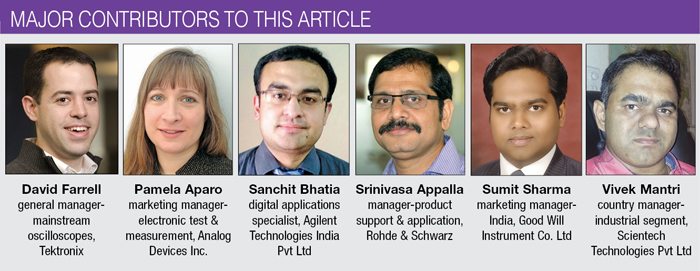Our fast-moving world needs to analyse data fast, and also on the move, informs Vivek Mantri, country manager-industrial segment, Scientech Technologies. He says, “Trending technology in telecom and RF segments needs data analysis to be extremely accurate in time to display waveforms, and in frequency to display signal spectra, where MDOs are a perfect choice.” However, he adds, “For most of the general-purpose requirements, analogue oscilloscopes are sufficient.”
Handheld, PC-based, phone and even a wristwatch scope
Oscilloscopes have evolved from the typical bench-top instruments to as small as a wristwatch, providing flexibility and an array of choices. Mantri defines today’s generation as tech-savy, that is more comfortable with touch screens and USB data transfers. He says, “They want their oscilloscopes to be handheld, with an easy interface, and prefer data transfers through SD cards. Different user segments will find analogue, MSO or PC-based instruments useful, depending on their usage.” Although, he maintains, no single technology can be suitable for all kinds of applications.
Today’s handheld oscilloscopes range from 20MHz to 500MHz in bandwidth, with sampling rates from 500Msa/s to 5GSa/s, and mostly come with LCD displays. Typically, with two channels, these are ideally suited for use by hobbyists, students, technicians and anyone else looking for an easy-to-use, affordable, single-channel PC oscilloscope.
PC-based oscilloscopes, complemented with software, provide bandwidth signal analysis anywhere between few tens of MHz to as high as 20GHz. These USB, modular devices typically have one, two, four or even eight channels with USB 2.0 or USB 3.0 interface, depending on the model. Some of them are even loaded with memory capacity. The software provided with these instruments is used to transfer instrument set ups, measurement data and images, and mostly favours the Windows operating system. But some oscilloscope makers are providing support for Linux, Mac OS X and even for Raspberry Pi.
Interestingly, apart from these, engineers can now perform analysis on their iPhones and on small devices such as a wristwatch scope (see the box titled ‘Exciting innovations in the last one year.’)
There are various other pocket-friendly oscilloscope devices available in the market for engineers. At the end of the day, it all depends on the engineer’s preference, purpose and understanding of the devices’ limitations. People will either love it or remain nonchalant with these innovations.
Knobs vs smart touch
Today, smart touch interfaces can be used to define areas where you want the oscilloscope to trigger. These interfaces are fully configurable. Traditional analogue scopes were designed for operation using dedicated knobs and buttons. However, the latest digital scopes incorporate touch-screen displays, enabling new operating concepts and enhancing ease of use, informs Appalla. He says, “As the model acceptance heavily depends on the user’s taste and experience, it is advantageous if instruments support multiple ways of operation—dedicated knobs, USB keyboard/mouse and touch-screen interface. An intuitive operating interface helps users to navigate faster and reduces time in setting up, executing and documenting measurements.”
Oscilloscope makers keep adding features to their instruments based on user demand for more signal analysis. “Good touch-screen implementations support drag-and-drop functionality for organising the display with multiple waveform diagrams and for selection of predefined operations. Other innovative user-interface concepts include colour-coding of buttons and knobs for guiding the user,” adds Appalla. In future, more touch-screen functionality, which is popular in consumer devices, will follow.

Sharing her personal experience, Aparo notes, “Although knobs and buttons are somewhat comforting when I start working with a new oscilloscope, I have to say that moving away from traditional knobs has made it easier to automate certain tests, and it has made it possible to save common configurations. The learning curve for using a new oscilloscope with multiple menu levels is higher than when purely analogue oscilloscopes were the only option—but this is also because the new oscilloscopes can do so much more.” She adds, “Obviously, having USB interfaces on oscilloscopes makes it easier to store test results and import them into other programs for writing reports or presentations.”
Although oscilloscope screens are evolving to capacitive touch interfaces with multi-touch capabilities that provide zoom capability and analysis capability with great ease, Bhatia believes that common traditional knobs like channel scaling, offset and trigger modes, to name a few, are being retained as the engineers are used to operating scopes with these knobs.
As the touch has been successfully implemented in mobile systems, more electronic devices will feature this technology. Sharma says, “In this fashion, a traditional hand-held oscilloscope is being upgraded to the full touch-screen hand-held scope as a next-generation transition. This may minimise the gap between high-end and low-end scopes and bring the whole new experience of using oscilloscopes to engineers.”








